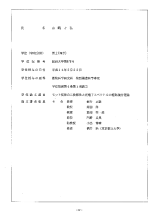モット転移の二段階性と光電子スペクトルの経路積分理論
この論文にアクセスする
この論文をさがす
著者
書誌事項
- タイトル
-
モット転移の二段階性と光電子スペクトルの経路積分理論
- 著者名
-
山崎, 才弘
- 著者別名
-
ヤマザキ, マサヒロ
- 学位授与大学
-
総合研究大学院大学
- 取得学位
-
博士 (理学)
- 学位授与番号
-
甲第575号
- 学位授与年月日
-
2002-03-22
注記・抄録
博士論文
The photoemission spectroscopy is the most standard method to determine the density of states (DOS) of electrons in solids. At present, the energy resolution of this photoemission spectrum (PES) overreaches a few meV, and the momentum resolution is also high enough to clarify the dispersion relation of the valence band electron. Thus, the photoemission spectroscopy can now clarify the natures of the electronic states more precisely than before. In particular, to clarify the natures of the electronic states just around the Fermi level is one of the most important issues in the solid state physics.<br /> In connection with this high resolution photoemission spectroscopy, the nature of the electronic states around the Fermi level of the perovskite-type compounds such as CaVO3 and SrVo3 is the matter of great interest. According to the recent experiments, a new peak structure has been observed around the Fermi level for CaVO3 and SrVo3, in addition to the well-known Hubbard-band peaks. This new peak at the Fermi level has such a double-peak structure that the intensity are suppressed just at the Fermi level but enhanced at slightly below and above this level. These experiments are performed by Osaka Univ. group and Tokyo Univ. group independently from each other. However, the resultant spectra are entirely same between these two independent groups. Thus, the origin of these new peaks, which are slightly below and above the Fermi level, has become a hot debating point.<br /> From the theoretical point of view, the PES directly corresponds to the Lehmann spectum of the one-body Green's function. Looking back on these past theoretical studies, the Lehmann spectra were calculated for the infinite dimensional Hubbard model by using the dynamical mean-field method. While the finite dimensional cases are also calculated by using the quantum Monte Carlo simulations, and by various other approximation methods. In particular, for one-dimensional systems, there are many studies including the exact results.<br /> In the infinite dimensional case, as is already well-known, a significant peak clearly appears at the Fermi level, if the Coulomb repulsion is weak enough to keep a metallic state. However, it has long been believed that, the peak at the Fermi level is the artifact of the infinite dimension. On the other hand, the peaked structure around the Fermi level is absent in the finite dimension. As mentioned before, for these finite dimensional cases, there are many calculations of the Lehmann spectra. However, all studies have been restricted only in strongly correlated cases. Within the quantum Monte Carlo method for one-, two- and three-dimensional systems, up to present, there is no theoretical study that predicts the appearance of such peaks around the Fermi level.<br /> For this reason, the purpose of the present paper is to clarify the DOS and the electronic property related with this new peak appeared around the Fermi level. In particular, we focus mainly on intermediately (or weakly) correlated regions concerning with the metal-insulator transition.<br /> We calculate the one-body Green's functions for one-dimensional half-filled Hubbard systems with various correlation strengths and temperatures, by using the quantum Monte Carlo method. The Lehmann's spectral functions of the one-body Green's functions are obtained by using the analytic continuation. In the region of the intermediate correlation strength and temperature, we will show some new peaks appear around the Fermi level, even in the case of one-dimensional system, just like the case of the infinite dimension. This new peak at the Fermi level splits into two peaks, as the temperature decreases or the on-site Coulomb repulsion increases. These theoretical results will be shown to agree with the recent experiments on CaVO3 and SrVo3 qualitatively, will also be examined in terms of a single impurity model.
総研大甲第575号
